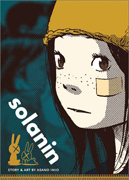by Morgan Giles
Take your typical tedious office job, and add the unrelenting depression of being in your mid-twenties, with a large dash of the annoyance of having a freeloading boyfriend. Shake until it’s all too much to bear, and garnish with the dawning realization that the world doesn’t have to work out for you. Serve cold, early in the morning, while shoved up against a stranger’s armpit on overcrowded public transportation.
Inio Asano’s Solanin doesn’t break the mold, but it offers something that not a lot of adulthood-sucks stories do: an earnest expression of what it feels like to be an aimless twentysomething, told with a rare maturity and self-awareness. The truly refreshing thing about Solanin is that the main character is a woman – one with all the same struggles, fears, and narrative sympathy usually found in over-simplified stories about slacker boys who don’t want to take responsibility for their lives.
Meiko is tired of being the sensible one, working in a dead-end job with a harassment-tastic boss just to support herself and her perpetually underemployed boyfriend. They’ve just been drifting since they graduated, depending on band practices and drinking sessions with college friends to get them through. She decides on a whim to quit her job and live on her savings for a while, but she finds that without a job, her life starts coming apart in ways she couldn’t have predicted.
Asano’s ability to create realistic, fully-formed female characters has led some reviewers on the internet to think the author must be a woman. He’s not, but the point still stands: Meiko and her friends, whether male or female, are developed so well that they feel like your own friends, with all the same hypocrisies, annoying quirks, and inconvenient feelings. They like the same bad indie rock you like. They’re just as afraid of turning into their parents, all the while inching inexorably towards total transformation. They drink away their sorrows sometimes, but they also have moments of happiness that make the rest of it bearable.
Asano’s other comic which is available in America, What a Wonderful World!, treads similar ground – it’s made up of loosely interlinked vignettes about Tokyoites who are directionless and feel brutalized by a world that holds little promise for them. The title is sarcastic in the extreme: both What a Wonderful World! and Solanin were written before the current economic crisis, but Japan has been dealing with the aftermath of economic meltdown for quite some time now. These stories are empathetic portrayals of young people who feel utterly abandoned by society, a theme which has been dwelt on in Japan for a while but which resonates equally in today’s America. And Asano’s stories don’t always have pretty outcomes.
His artistic style makes Asano’s comics real stand-outs among most of the manga available in the US. While still identifiably manga in style, his artwork takes a sharp turn away from the saucer eyes and short skirts favored by more popular artists towards a more realistic, but also impressionistic style. Asano’s character designs epitomize his careful observation of the world–their clothes, their hair, and their facial expressions are just as lucidly depicted as their feelings about their lives. Asano often incorporates visual irony in a gentle and effective way, using it to keep the tone from plunging too far into self-pitying misery. The image of the sold-out punk of What a Wonderful World! standing on his balcony, naked except for his necktie, reminds us not to take his sorrow or our own too seriously.
Asano turned thirty this year but he continues to be a fresh, honest voice for young people in Japan and, now, in America. His insistence that the small, perhaps imperceptible personal struggles people go through matter makes for interesting storytelling. His art style might not make him instantly at home with other manga artists or with Western graphic novelists, but readers who are happy to look beyond the surface will find well-crafted comics that will shake up their perceptions of modern Japanese comics and, perhaps, their own internal worlds.
This post may contain affiliate links.









